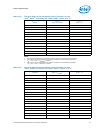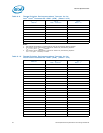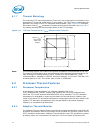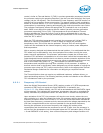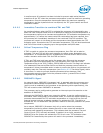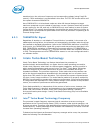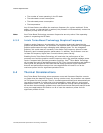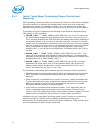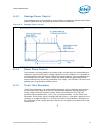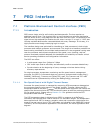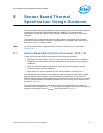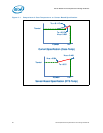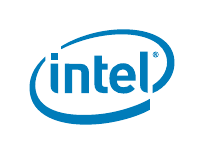
Thermal/Mechanical Specifications and Design Guidelines 59
Thermal Specifications
• The number of cores operating in the C0 state.
• The estimated current consumption.
• The estimated power consumption.
•The temperature.
Any of these factors can affect the maximum frequency for a given workload. If the
power, current, or thermal limit is reached, the processor will automatically reduce the
frequency to stay with its TDP limit.
Note: Intel Turbo Boost Technology processor frequencies are only active if the operating
system is requesting the P0 state.
6.3.2 Intel
®
Turbo Boost Technology Graphics Frequency
Graphics render frequency is selected by the processor dynamically based on the
graphics workload demand. The processor can optimize both processor and integrated
graphics performance through managing total package power. For the integrated
graphics, this could mean an increase in the render core frequency (above its base
frequency) and increased graphics performance. In addition, the processor core can
increase its frequency higher than it would without power sharing.
Enabling Intel
®
Turbo Boost Technology will maximize the performance of the
processor core and the graphics render frequency within the specified package power
levels. Compared with previous generation products, Intel
®
Turbo Boost Technology
will increase the ratio of application power to TDP. Thus, thermal solutions and platform
cooling that are designed to less than thermal design guidance might experience
thermal and performance issues since more applications will tend to run at the
maximum power limit for significant periods of time.
6.4 Thermal Considerations
Intel Turbo Boost Technology allows processor cores and Processor Graphics cores to
run faster than the baseline frequency. During a turbo event, the processor can exceed
its TDP power for brief periods. Turbo is invoked opportunistically and automatically as
long as the processor is conforming to its temperature, power delivery, and current
specification limits. Thus, thermal solutions and platform cooling that are designed to
be less than thermal design guidance may experience thermal and performance issues
since more applications will tend to run at or near the maximum power limit for
significant periods of time.



